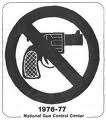Some U.S. Cities Have Higher Gun Violence Than Entire Countries

By Chris Miles
When it comes to gun murders in America, some American cities rank among the most dangerous in the world — even when they’re compared to entire countries.
This map parallels the rate of gun murders in American cities to entire nations.
The bigger the dot, the worse it is.
For the United States as a whole, the rate of gun homicides is about 3 per 100,000 people. Honduras is the country with the world’s highest gun homicide rate, around 68 gun murders per 100,000 people.

The Martin Prosperity Institute compiled the data, building on statistics from the Centers for Disease Control and Prevention, additional data from the United Nations Office on Drugs and Crime and other sources collected by The Guardian. The statistics are budled and from a mix of international crime data (which can be incomplete) and homicide data (which is more reliable).
Each dot represents gun murders per 100,000 people. For the United States as a whole, the rate of gun homicides is about 3 per 100,000 people. Honduras is the country with the world’s highest gun homicide rate, around 68 gun murders per 100,000 people.
New York, with a population of more than 8 million, had 237 people killed by guns in 2012, for a rate of around 3 gun homicides per 100,000 people. New York is a comparatively small dot. Still, New York has more gun murders than Argentina, which has a population over 41 million.
What’s the most dangerous city in the world? That would be Honduras’ San Pedro Sula. Shockingly, San Pedro Sula had 1,218 murders for 719,447 inhabitants in 2012.
Here’s how things shake out:
– If it were a country, New Orleans (with a rate 62.1 gun murders per 100,000 people) would rank second in the world.
– Detroit’s gun homicide rate (35.9) is just a bit less than El Salvador (39.9).
– Baltimore’s rate (29.7) is not too far off that of Guatemala (34.8).
– Newark (25.4) and Miami (23.7) have gun murder statistics comparable to Colombia (27.1).
– Washington D.C. (19) has a higher rate of gun homicide than Brazil (18.1).
– Atlanta’s rate (17.2) is about the same as South Africa (17).
– Cleveland (17.4) has a higher rate than the Dominican Republic (16.3).
– Gun murder in Buffalo (16.5) is similar to Panama (16.2).
– Houston’s rate (12.9) is slightly higher than Ecuador’s (12.7).
– Gun homicide in Chicago (11.6) is similar to Guyana (11.5).
– Phoenix’s rate (10.6) is slightly higher than Mexico (10).
– Los Angeles (9.2) is comparable to the Philippines (8.9).
– Boston rate (6.2) is higher than Nicaragua (5.9).
– New York, where gun murders have declined to just four per 100,000, is still higher than Argentina (3).
– Even the cities with the lowest homicide rates by American standards, like San Jose and Austin, compare to Albania and Cambodia respectively.
The numbers give a stark portrait of American urban centers and the laws (or lack thereof) that seek to maintain safety in these cities. Other points on American gun culture itself, of course, can be teased out, but that’s a whole different story.
Copyright Policymic.com, 2013
http://www.policymic.com/articles/70199/some-u-s-cities-have-higher-gun-violence-than-entire-nations-check-this-map

